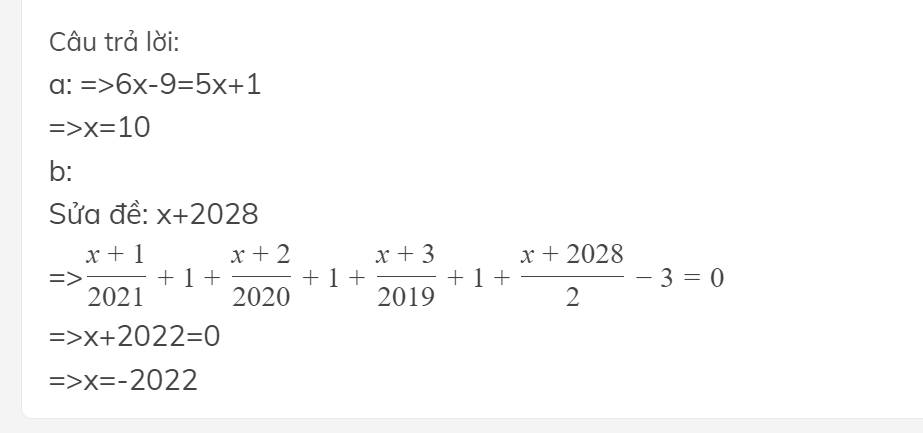
Hãy nhập câu hỏi của bạn vào đây, nếu là tài khoản VIP, bạn sẽ được ưu tiên trả lời.


\(\dfrac{x-1}{2023}+\dfrac{x-2}{2022}=\dfrac{x-3}{2021}+\dfrac{x-4}{2020}\)
`<=>(x-1)/2023-1+(x-2)/2022-1=(x-3)/2021-1+(x-4)/2020-1`
`<=>(x-2024)/2023+(x-2024)/2022=(x-2024)/2021+(x-2024)/2020`
`<=>(x-2024)(1/2023+1/2022-1/2021-1/2020)=0`
`<=>x-2024=0(1/2023+1/2022-1/2021-1/2020>0)`
`<=>x=2024`
=>\(\left(\dfrac{x-1}{2023}-1\right)+\left(\dfrac{x-2}{2022}-1\right)=\left(\dfrac{x-3}{2021}-1\right)+\left(\dfrac{x-4}{2020}-1\right)\)
=>x-2024=0
=>x=2024

Câu 1:
1: Ta có: \(P=\left(\dfrac{x^2}{x^2-3}+\dfrac{2x^2-24}{x^4-9}\right)\cdot\dfrac{7}{x^2+8}\)
\(=\left(\dfrac{x^2\left(x^2+3\right)}{\left(x^2-3\right)\left(x^2+3\right)}+\dfrac{2x^2-24}{\left(x^2-3\right)\left(x^2+3\right)}\right)\cdot\dfrac{7}{x^2+8}\)
\(=\dfrac{x^4+3x^2+2x^2-24}{\left(x^2-3\right)\left(x^2+3\right)}\cdot\dfrac{7}{x^2+8}\)
\(=\dfrac{x^4+5x^2-24}{\left(x^2-3\right)\left(x^2+3\right)}\cdot\dfrac{7}{x^2+8}\)
\(=\dfrac{x^4+8x^2-3x^2-24}{\left(x^2-3\right)\left(x^2+3\right)}\cdot\dfrac{7}{x^2+8}\)
\(=\dfrac{x^2\left(x^2+8\right)-3\left(x^2+8\right)}{\left(x^2-3\right)\left(x^2+3\right)}\cdot\dfrac{7}{x^2+8}\)
\(=\dfrac{\left(x^2+8\right)\left(x^2-3\right)}{\left(x^2-3\right)\left(x^2+3\right)}\cdot\dfrac{7}{x^2+8}\)
\(=\dfrac{7}{x^2+3}\)
Câu 2a đề sai, pt này ko giải được
2b.
\(P\left(x\right)=\left(2x+7\right)\left(x^2-4x+4\right)+\left(a+20\right)x+\left(b-28\right)\)
Do \(\left(2x+7\right)\left(x^2-4x+4\right)⋮\left(x^2-4x+4\right)\)
\(\Rightarrow P\left(x\right)\) chia hết \(Q\left(x\right)\) khi \(\left(a+20\right)x+\left(b-28\right)\) chia hết \(x^2-4x+4\)
\(\Leftrightarrow\left\{{}\begin{matrix}a+20=0\\b-28=0\end{matrix}\right.\) \(\Rightarrow\left\{{}\begin{matrix}a=-20\\b=28\end{matrix}\right.\)
3a.
\(VT=\dfrac{1}{1+x^2}+\dfrac{1}{1+y^2}=\dfrac{2+x^2+y^2}{1+x^2+y^2+x^2y^2}=1+\dfrac{1-x^2y^2}{1+x^2+y^2+x^2y^2}\le1+\dfrac{1-x^2y^2}{1+2xy+x^2y^2}\)
\(VT\le1+\dfrac{\left(1-xy\right)\left(1+xy\right)}{\left(xy+1\right)^2}=1+\dfrac{1-xy}{1+xy}=\dfrac{2}{1+xy}\) (đpcm)
3b
Ta có: \(n^3-n=n\left(n-1\right)\left(n+1\right)\) là tích 3 số nguyên liên tiếp nên luôn chia hết cho 6
\(\Rightarrow n^3\) luôn đồng dư với n khi chia 6
\(\Rightarrow S\equiv2021^{2022}\left(mod6\right)\)
Mà \(2021\equiv1\left(mod6\right)\Rightarrow2021^{2020}\equiv1\left(mod6\right)\)
\(\Rightarrow2021^{2022}-1⋮6\)
\(\Rightarrow S-1⋮6\)

Lời giải :
\(\dfrac{x^2}{a^2}+\dfrac{y^2}{b^2}+\dfrac{z^2}{c^2}=\dfrac{x^2+y^2+z^2}{a^2+b^2+c^2}\Leftrightarrow\dfrac{x^2}{a^2+b^2+c^2}-\dfrac{x^2}{a^2}+\dfrac{y^2}{a^2+b^2+c^2}-\dfrac{y^2}{b^2}+\dfrac{z^2}{a^2+b^2+c^2}-\dfrac{z^2}{c^2}=0\)
\(\Leftrightarrow x^2\left(\dfrac{1}{a^2+b^2+c^2}-\dfrac{1}{a^2}\right)+y^2\left(\dfrac{1}{a^2+b^2+c^2}-\dfrac{1}{b^2}\right)+z^2\left(\dfrac{1}{a^2+b^2+c^2}-\dfrac{1}{c^2}\right)=0\)
Do \(\dfrac{1}{a^2+b^2+c^2}-\dfrac{1}{a^2}\ne0;\dfrac{1}{a^2+b^2+c^2}-\dfrac{1}{b^2}\ne0;\dfrac{1}{a^2+b^2+c^2}-\dfrac{1}{c^2}\ne0\)
\(\Rightarrow\) \(\left\{{}\begin{matrix}x^2=0\\y^2=0\\z^2=0\end{matrix}\right.\) \(\Rightarrow\)\(\left\{{}\begin{matrix}x=0\\y=0\\z=0\end{matrix}\right.\)
Thay vào biểu thức P :
\(P=0^{2020}+\left(y-1\right)^{2022}+\left(z-1\right)^{203}=0+1-1=0\)

Ta có: VT = \(\dfrac{x+1}{2021}\)+1 - (\(\dfrac{x+2}{2020}\)+1) = \(\dfrac{x+3}{2019}\)+1=VP
=>\(\dfrac{x+2022}{2021}+\dfrac{x+2022}{2020}-\dfrac{x+2022}{2019}=0\)
=>\(\left(x+2022\right)\left(\dfrac{1}{2021}+\dfrac{1}{2020}-\dfrac{1}{2019}\right)=0\)
=>x +2022 = 0=> x =-2022

Câu 2
1, a, \(x^2+9xy+8y^2-8y-x=x^2+xy+8xy+8y^2-\left(8y+x\right)\)
\(=\left(x+y\right)\left(8y+x\right)-\left(8y+x\right)=\left(8y+x\right)\left(x+y-1\right)\)
b, \(x^3+5x-6=x^3-x^2+x^2-x+6x-6\)
\(=x^2\left(x-1\right)+x\left(x-1\right)+6\left(x-1\right)=\left(x-1\right)\left(x^2+x+6\right)\)

oh no bài thứ nhất là dạng chứng minh cs đúng ko ,
ko thể nào là dạng tìm a,b,c đc-.-

\(=\dfrac{1}{x}-\dfrac{1}{x+2}+\dfrac{1}{x+2}-\dfrac{1}{x+4}+...+\dfrac{1}{x+2020}-\dfrac{1}{x+2022}\)
\(=\dfrac{x+2022-x}{x\left(x+2022\right)}=\dfrac{2022}{x\left(x+2022\right)}\)

\(\dfrac{x}{2020}\) + \(\dfrac{x+1}{2021}\) + \(\dfrac{x+2}{2022}\) + \(\dfrac{x+3}{2023}\) = 4
\(\dfrac{x}{2020}\) + \(\dfrac{x+1}{2021}\) + \(\dfrac{x+2}{2022}\) + \(\dfrac{x+3}{2023}\) - 4 = 0
(\(\dfrac{x}{2020}\) - 1) + (\(\dfrac{x+1}{2021}\) - 1) + (\(\dfrac{x+2}{2022}\) - 1) + (\(\dfrac{x+3}{2023}\) - 1) = 0
\(\dfrac{x-2020}{2020}\) + \(\dfrac{x-2020}{2021}\) + \(\dfrac{x-2020}{2022}\) + \(\dfrac{x-2020}{2024}\) = 0
\(\left(x-2020\right)\).(\(\dfrac{1}{2020}\) + \(\dfrac{1}{2021}\) + \(\dfrac{1}{2022}\) + \(\dfrac{1}{2024}\)) = 0
\(x\) - 2020 = 0
\(x\) = 2020
Vậy \(x=2020\)